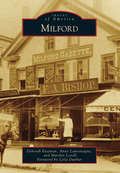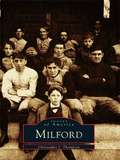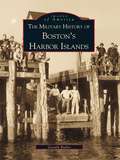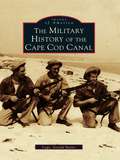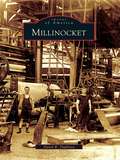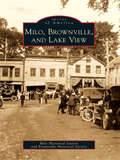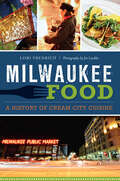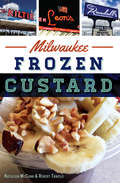- Table View
- List View
Milestones of Space: Eleven Iconic Objects for the Smithsonian National Air and Space Museum
by Michael J. NeufeldA history of exploration through eleven objects from the Air and Space Museum: “Takes you behind the scenes with firsthand stories and rare photos.” —William F. Readdy, former NASA astronaut and Space Shuttle commanderThroughout human history, across cultures and landscapes, countless individuals have gazed with wonder in the same direction: upward. Getting to space was no easy task, and our quest to further explore the universe, to understand the impossibly vast heavens, continues.In Milestones of Space, Michael Neufeld and select curators of the Smithsonian National Air and Space Museum present a gorgeous photographic celebration of some of the most groundbreaking artifacts that played key parts in giving humanity its first steps into the cosmos. Focusing on the most iconic objects and technology—such as Friendship 7, the Lunar Module 2, Neil Armstrong’s Lunar Suit, the Hubble Space Telescope, and Space Shuttle Discovery—this book extensively profiles eleven of the NASM’s most important breakthroughs in space technology.The NASM curators feature each object in incredible detail with compelling timelines, sidebars and captions, and over 150 archival images that provide new and little-known insights into their development and historical context. We are still a long way from grasping our universe—but for now, Milestones of Space magnificently commemorates the individuals and inventions that have taken us this far.
Milford
by Anne Lamontagne Marilyn Lovell Leila Dunbar Deborah EastmanIn 1670, Puritan pioneers colonized the Nipmuck Indian territory that would develop into the town of Milford, officially incorporated in 1780. Its advantageous location between the Mill and Charles Rivers created a convenient commercial center. By 1850, major railway lines traversed routes to Boston and New York, enabling Milford to develop the largest boot-and-shoe industry in the nation. When pink granite was discovered in the late 1800s, Milford's stone business boomed. The quarries and factories attracted skilled European immigrants who made the area home. The community grew, establishing cultural commitments to education, music, and athletics. Dr. Joseph E. Murray, winner of the Nobel Prize in Medicine, and Col. Alexander Scammell, a hero of the Revolutionary War, were both sons of Milford. Today, Milford continues to prosper with successful businesses like Consigli Construction, Archer Rubber, and Waters Corporation. The town is also noted for the Milford Regional Medical Center, which ranks as a premier facility in New England.
Milford
by Christopher J. ThompsonSettled on the edge of the Monadnock region, Milford is a growing community that has managed to maintain its small-town charm. Residents have taken great pride in their community through the years. In 2002, the National Trust for Historic Preservation awarded Milford one of only five national Great American Main Street Awards for the revitalization of the downtown area, an award that would not have been possible without much volunteer and team effort.With pictures and words, Milford looks back at the people, places, and events that have molded the community into the appealing one it is today. It contains views of places that have been gone for decades: the White Elephant shop, the Milford Inn, French & Heald furiture company, and the many working granite quarries, which in their time earned Milford the nickname the "granite town of the Granite State." Well represented are the historic downtown area and the common, known also as "the oval" since it bore that shape in the 1800s.
Milford (Images of America)
by Dave KentonMilford, Delaware, is a unique town in the heart of southern Delaware with one foot in Kent County and the other in Sussex County. Location is a major thread of success for Milford-it is within 100 miles of Washington, D.C., Philadelphia, and Baltimore and only a short 25-minute drive to the Delaware beaches. Greater Milford offers a rare blend of relaxed rural life and progressive, modern convenience. The historic district, riverfront greenway, and civic-minded residents lend a charm to Milford not found in every small town.Visit Milford of days gone by and glimpse the early English settlers who would shape tracts of land into a promising town. See how the area once called "Saw Mill Range" evolved from primitive woodlands into the commercial center known as Milford. Distinguish all the enterprising leaders who made Milford a thriving town with their innovations like canning and fruit drying and shipbuilding. The Mispillion River, Marshall's Mill, Milford Chronicle, Calvary Church, Slaughter Beach Hotel, Cedar Neck, the Levin Crapper Mansion built in 1763, Purity Row, along with the people, businesses, and events presented in this photographic celebration showcase what makes Milford an exceptional place to live and prosper.
Milford (Then and Now)
by Michael F. ClarkOn August 22, 1914, Milford, Connecticut, celebrated its 275th anniversary. An estimated crowd of 20,000 celebrated on the Milford Green alongside open-air horseless buggies. The celebration started at sunrise with a cannon salute and the sounding of church bells and factory whistles. Milford just recently celebrated its 375th anniversary.
Military History of Boston's Harbor Islands, The (Images of America)
by Gerald ButlerThis accurate pictorial history will acquaint the reader with the seacoast defenses of Boston Harbor. Fortified since the the 1600s, seacoast defenses provided important protection for the new seaport. By the Civil War, strong granite fortresses guarded the seaward approaches to the Port of Boston. Later, powerful long-range guns and mortars protected the seaport. During World War II, the most sophisticated and powerful guns existing were installed. These guns used the first computers and radar systems developed for the military for target acquisition and tracking. In The Military History of Boston's Harbor Islands, great care has been taken to identify harbor defense systems at all of the harbor islands, mainland forts, and the observation and radar towers from Nahant to Scituate. The book identifies and explains the long-abandoned granite and concrete monoliths of Boston Harbor. The Military History of Boston's Harbor Islands brieflydescribes Edgar Allan Poe's tour of duty in Boston Harbor, the impact that Col. Sylvanus Thayer had on Boston's seacoast fortifications, and many mysterious structures at the harbor forts.
Military History of the Cape Cod Canal, The (Images of America)
by Capt. Gerald ButlerDuring World War II, with Allied merchant and navy ships under the threat of German U-boats, the eastern seaboard was on high alert. The Cape Cod Canal, a vital waterway for commercial and military traffic, underwent a period of strict control, occupation, and defense. This pictorial history documents the activity during that time and the extensive array of weaponry and manpower brought to bear in coastal defense.In The Military History of the Cape Cod Canal, the abandoned foundations at Sagamore Hill and throughout most of Buzzards Bay are explored, as well as the weapons, devices, and personnel assigned to ensure the canal's integrity throughout the war. Although the responsibilities of the U.S. Army's Coast Artillery are a focal point, the actions of the U.S. Navy, the U.S. Coast Guard, and the air arms of all the military services during World War II are also included. The Military History of the Cape Cod Canal documents the mishaps, collisions, and war-damaged ships in and near the canal, as well as the joint military protection forces and plans in effect during World War II.
Millennials, Spirituality and Tourism (Routledge Insights in Tourism Series)
by Sandeep Kumar Walia Aruditya JasrotiaThis book offers a conversant and comprehensive overview of the themes and concepts in spiritual tourism and Millennial tourists. Providing interdisciplinary insights from leading international researchers and academicians, this makes a critical contribution to the knowledge around spiritual tourism. Organized into four parts, the edited book provides modern and cutting-edge perspectives on important topics like linkages between spirituality and tourism, the predicament of spirituality in tourism among Millennials, anthropological views on spirituality, the work-life-balance, marketing of spiritual tourism destinations and the issues, threats and prospects of spiritual tourism in the emerging era. Part I introduces core concepts, theories on spiritual tourism and links it with the Millennial world. Part II explores the inclinations of millennials towards spirituality and their travel motivations, experiences, behaviours with special reference to spirituality. In Part III, on holistic tourism, the role of digitization in spiritual tourism adoption, marketing and management perspectives with special reference to Millennials are discussed. Part IV examines the issues, threats, policies and practices linked with spiritual tourism. This part also aims to explore the future challenges, opportunities for spiritual tourism development and to propose research-based solutions. Overall, the book will be a suitable means of getting insight into the minds of the diverse, experimental and open-minded generation of millennials. This book will fill the gap of research on spiritual tourism. As an edited book, it will add on new research and knowledge base with high quality contributions from researchers and practitioners interested in tourism management, hospitality management, business studies regional development and destination management.
Miller Place (Images of America)
by Mindy Kronenberg Edna Davis Giffen Candace LindemannSituated on top of the bluffs facing Long Island Sound, Miller Place is a treasure trove of Long Island history. With the arrival of the railroad in the late 1800s, the beaches became a popular holiday and summer camp destination. Initially boardinghouses served vacationers until proprietors opened inns and resorts. Throughout the 20th century, Miller Place attracted vacationers from nearby New York City, including Paul Newman, Arthur Miller, and a young Anjelica Huston. Drawn by its bucolic setting, friendly atmosphere, and career opportunities at nearby Stony Brook University and Hospital, commuters in the 1970s and 1980s expanded and updated vacation homes and developed new lots. As the population grew, the civic-minded residents formed their own high school, fire department, historical society, civic association, and the North Shore Youth Council. Miller Place's historic homes, natural spaces, and strong public schools make the hamlet a desirable place to raise a family.
Millington-Arbela Area 1854-2004, The: 1854-2004 (Images of America)
by Millington-Arbela Historical SocietySince settlers first arrived in the mid-1800s, the townships of Millington and Arbela have developed into strong communities with deep cultural roots. This informative book documents the Millington-Arbela area's growth and progress over the course of 150 years, exploring founding families, village growth, religion, business, and education through rare archival photographs and postcards. In celebration of the region's sesquicentennial anniversary, the Millington-Arbela Historical Society takes readers on a detailed visual tour of the area's rich history, revealing the remarkable people, places, and events that have shaped the townships as they are known today.
Millinocket
by David R. DupliseaThe town of Millinocket rests at the junction where the West Branch of the Penobscot River and the Millinocket Stream converge. In 1898, settlers arrived in the area and carved a town out of the wilderness, constructing the Great Northern Paper Company, the largest paper mill in the world at that time. Utilizing the waterways, lumbermen floated the logs downriver to feed the mill and export paper around the globe. The town and mill sprang up practically overnight, built at a fevered pace to keep up with the paper demand, and gave Millinocket the nickname "Magic City in Maine's Wilderness." Today Millinocket is the closest town to the famous Baxter State Park and Maine's highest peak, Mount Katahdin. As the gateway to the Allagash region, Millinocket draws tourists year-round with its numerous outdoor activities.
Mills Along the Carson River
by Daniel Dan" WebsterNestled along the picturesque Carson River in the state of Nevada were the quartz mills that crushed and extracted the values from the Comstock ore. These mills were built starting in 1859, when gold and silver were discovered on the Comstock, with the last mill being demolished around the 1920s. Mills were huge plants, in many cases crushing tons of ore a day, sometimes seven days a week. To support these mills, the towns of Empire and Dayton were established to house workers and provide needed supplies. Remnants of these mills have all but disappeared, and in a few more years, there will be nothing to remind people of the wealth these establishments created for individuals, the state of Nevada, and the United States.
Mills of Humboldt County (Images of America)
by Fortuna Depot Museum Alex Service Susan J. O’haraHumboldt County was at the forefront of the massive redwood logging industry. The impressive size of the trees necessitated drastic technological advances. Many innovations were invented by Humboldt mill owners like John Dolbeer, whose steam donkey engine mechanized and revolutionized logging all along the West Coast. In 1896, there were 13 mills devoted to sawing redwood lumber and 26 mills making redwood shingles operating in Humboldt County. Other related industries, such as shipbuilding, boiler works, tanbark, and split products, further shaped the economic vitality of the county. Most of these industries no longer exist, and the logging industry is now a shadow of its former self. However, many remnants of the loggers' heyday can still be found. This book explores the sites of Humboldt County's historic lumber industry and the day-to-day realities of life in the mills and the woods.
Millville
by Ann Pratt HouptThe town of Millville, Florida, was born out of the need for lumber to build houses and ships in the late 1800s, when settlers coming to St. Andrews Bay had no way to travel but by sailing vessels. Millville had a sawmill, a shipyard, and several stores. In the winter of 1885-1886, several familiesorganized a Sunday school. They built a small schoolhouse, and the newly formed Watson's Bayou Literary Society met. By 1910, it was the largest community around the bay and the center of commerce and industry for the area. In 1913, leaders incorporated the town, and voters elected W.I. Singletary their first mayor. The future was bright. By 1918, 2,000 residents lived in the town ith hotels, a theater, 31 business establishments, and several churches. Millville was still the largest town on St. Andrews Bay, but just to the west was the growing town of Panama City. In 1926, Millville was annexed into the incorporated limits of Panama City.
Milo, Brownville, and Lake View (Images of America)
by Brownville Historical Society Milo Historical SocietyIn the wilderness of Piscataquis County, rich in river power and vast with untouched forests, three communities were born. Although each is close in proximity, Milo, Brownville, and Lake View have unique histories and personalities. Milo's beginnings are based on the legend of young Theophilus Sargent, who faced the wild alone, almost perishing but for the kindness of a Native American chief and his son, Attean. One hundred years later, this survival story became the basis for Elizabeth George Speare's book Sign of the Beaver. Along with its grist- and sawmill industries, Brownville's slate quarries were prolific and offered Welsh immigrants a wealth of employment. Lake View Plantation was born because of timber. Merrick Thread Company built a spool mill near Schoodic Lake, whose shores were abundant with birch, and even after the mill closed the community of Lake View remained. Its small permanent population now swells to more than 1,000 in the summer as visitors flock to the beautiful shores of natural spring-fed Schoodic Lake.
Milton (Images of America)
by Milton Historical Society Doug WelchWhen the traveling party with Joseph Goodrich concluded a months-long journey west from Alfred, New York, in the spring of 1838, the strong-willed abolitionist staked out land some 60 miles west of Milwaukee. The area was then a crossroads of militia trails still worn from the Black Hawk War six years prior. Wisconsin's statehood was 10 years away when Goodrich began platting a community. He began with the Milton House, a unique hexagonal structure made of grout and built to serve as a temperance inn. Later, Goodrich used Milton House to aid fugitive slaves fleeing the South, and the inn became the heart of the community. By 1844, Milton had expanded around the town square. That same year, Goodrich founded Milton Academy, which was chartered as a college in 1867. He also facilitated the arrival of railroad lines, which led to the establishment of Milton's twin village, Milton Junction, the rail hub of southern Wisconsin.
Milwaukee Food: A History of Cream City Cuisine (American Palate Ser.)
by Lori FredrichA local food writer exploreshow a humble Midwest town developed a food scene unlike any other American city and became a culinary destination of its own. Milwaukee&’s culinary scene boasts more than the iconic beer and bratwurst. It possesses a unique food culture as adventurous as any dining destination in the country. Sample the spreads at landmark hotels like the Pfister that established the city&’s hospitable reputation, as well as eateries like Mader&’s that cemented it. Meet the producers, chefs and entrepreneurs who helped expand Milwaukee&’s palate and pushed the scene to the forefront of the farm-to-fork movement. Milwaukee native and food writer Lori Fredrich serves up the story of a bustling blue-collar town that became a mecca for food lovers and a rising star in the sphere of urban farming.
Milwaukee Frozen Custard (American Palate)
by Robert Tanzilo Kathleen MccannFrozen custard is more than a dessert in Milwaukee. It's a culture, a lifestyle and a passion. From the stand that inspired television's Happy Days to the big three--Gilles, Leon's and Kopp's--take a tour through the history of this guilty pleasure. Learn about its humble origins as an unexpected rival to ice cream and its phenomenal success as a concession at the Chicago World's Fair in 1933 that made the snack famous. Find the stories behind your favorite flavor at local festivals and homegrown neighborhood stands. Milwaukee authors and editors Kathleen McCann and Robert Tanzilo launch a celebration of custard lore, featuring a stand guide and much more. Dig into what makes Milwaukee the Frozen Custard Capital of the World.
Milwaukee Ghosts and Legends (Haunted America)
by Anna LardinoisA tour guide and founder of Gothic Milwaukee shares the spine-tingling tales of the Beer City's famous, and not so famous, specters and legends. Beneath Milwaukee's calm façade, its ghastly past awaits. The overbearing spirit of Frederick Pabst keeps persistent watch over the mansion that shares his name. The remains of the Newhall House Fire, the city's deadliest disaster, may lie beneath a new building, but those who lost their lives that night refuse to rest in peace. Even the suburbs hold their share of ghoulish secrets, including the furtive dwarves of Haunchyville, the fabled Bray Road Beast and the stubborn spirits lurking in Deacon West's house. &“A breeze—a spine-tingling breeze—to read. It's extremely well crafted, organized into deliciously digestible segments and laden with descriptive yet straight-forward language. Lardinois stocks the stories with so many peculiar historical tidbits that the text is simultaneously scary, fascinating and educational. (Did you know the ashes of the founder of The Skylight Theater are still beneath the stage?)&” —OnMilwaukee.com
Milwaukee's Brady Street Neighborhood
by Frank D. AliotoMilwaukee's Brady Street neighborhood, bounded by the Milwaukee River, Lake Michigan, Ogdon Avenue, and Kane Place, is arguably the most densely-populated square mile in the state of Wisconsin. A mix of historic shops, single-family homes, apartments, and condos, Brady Street boasts of great diversity that draws from many distinct eras. It began in the mid-19th century as a crossroads between middle-class Yankees from the east and early German settlers. Polish and Italian immigrants soon followed, working the mills, tanneries, and breweries that lined the riverbank. After these groups had assimilated and many of their descendents moved to the suburbs, the hippies in the 1960s arrived with their counterculture to fill the void. By the 1980s, the area fell into blight, neglect, and decay; now, a true model for new urbanism, the Brady Street neighborhood is in the midst of a renaissance.
Milwaukee's Historic Bowling Alleys (Images of America)
by Manya KaczkowskiFrom the U.S. Olympic team, to "Bowling with the Champs," to countless corner bars with a couple of lanes in the basement, Milwaukee has lived and breathed this sport. In the late 1800s, German brewers like Capt. Frederick Pabst and the Uihleins offered bowling in their Milwaukee beer gardens. When Abe Langtry brought the American Bowling Congress here in 1905, "Brew City" became bowling central. Today owning a bowling alley is a labor of love, with good reason. It's the place where you rolled that 700 series, met your wife, and taught your son how to bowl in the junior league. Even in this high-tech, immediate-gratification society, bowling still thrives in Milwaukee. Several old-school lanes still have steady business, and this book is a tribute to the people, the places, and the sport that made Milwaukee "America's Bowling Capital."
Milwaukee, Wisconsin
by Richard PrestorIn April 1834, the Green-Bay Intelligencer newspaper reported that a sawmill was being erected in a new settlement on the Milwaukee River. Less than one year later, the paper reported that "Milwaukey [sic], which 10 months ago, had only a single trading house, has now some 20 or 30 houses, and two or three saw mills." Yankee settlers and land speculators had moved in and were here to stay. The steady growth of Milwaukee was never wholly due to the influx of ambitious Easterners though. In ever-expanding numbers, Europeans also made their way here, not merely as settlers, but frequently as hard-working business owners, skilled laborers, and artists. They were determined to make Milwaukee their home, and in this new homeland they surrounded themselves (and influenced the entire community) with their old traditions and languages. Thirty years after its first newspaper write-up, Milwaukee was a well-established city brimming with potential.
Mind Your Manners
by John MoleUnderstanding the nature of cultural diversity is one thing-managing it day-to-day is quite another! When doing business internationally, culture shock-and sometimes culture clash-is unavoidable. John Mole's Mind Your Manners: Managing Business Cultures in the New Global Europe is a comprehensive guide that explores cultural aspects of dozens of individual European countries as they relate to global business. Now in a fully expanded and updated third edition, Mind Your Manners includes every countriy-from the Baltics to the Balkans-applying for membership to the European Union, the world's biggest global market, and many others.Based on interviews, surveys, and workshops with over a thousand managers (of fifty nationalities), Mind Your Manners describes Europe's extraordinary political, economic, and social changes and their effects on the way we work together. New chapters on diversity, change, body language, and negotiation identify the key elements that shape the business and cultural environment of the continent, and Euroquizzes will test your knowledge and demonstrate the broad cultural spectrum of European nations. More than a mere catalog, Mind Your Manners is a must-read for anyone who intends to succeed in the European Union.
Mind of a Survivor: What the wild has taught me about survival and success
by Megan Hine***Shortlisted for the Great Outdoors Book of the Year***Surviving in the wild takes a great deal of strength. Often faced with frozen tundra, sweltering deserts, humid jungles, perilous mountains and fast-flowing rivers, Megan Hine is no stranger to perilous conditions. Whilst leading expeditions and bushcraft survival courses and in her work on television shows such as Bear Gryll's Mission Survive and Running Wild, she has explored the corners of the globe in pursuit of adventure.Faced with the toughest of conditions: bad weather; lack of food and being in the presence of predators, is the ultimate test of character and often the biggest challenge to overcome is in the head. In these situations, the human brain is simultaneously the greatest asset and biggest liability. Not everyone is suited to the great outdoors and when danger calls many aren't as well-equipped to survive, no amount of top of the range kit will save you if you don't have the right frame of mind. Here Megan Hine examines the human ability and instinct for survival, showing us how others have developed the attitudes and attributes to thrive in the most dangerous situations, and how those same attitudes and attributes help them confront problems and obstacles at work and at home. Being chased through the jungle by armed opium farm guards, abseiling past bears and lighting fires with tampons, Megan has seen and done it all. In Mind of a Survivor she takes you along for a series of life-and-death adventures and shows you what happens to people when they are pushed to their limits. Inspirational rather than instructional, Megan examines the human ability and instinct for survival sharing the life tools that she uses and showing how they can as easily be applied to more domestic everyday life - from careers to relationships, from overcoming adversity to decision making. Filled with her own experiences, Mind of a Survivor is packed full of adventure and can help people survive in any situation and cope with whatever life throws at them.
Mind of a Survivor: What the wild has taught me about survival and success
by Megan Hine***Shortlisted for the Great Outdoors Book of the Year***Surviving in the wild takes a great deal of strength. Often faced with frozen tundra, sweltering deserts, humid jungles, perilous mountains and fast-flowing rivers, Megan Hine is no stranger to perilous conditions. Whilst leading expeditions and bushcraft survival courses and in her work on television shows such as Bear Gryll's Mission Survive and Running Wild, she has explored the corners of the globe in pursuit of adventure.Faced with the toughest of conditions: bad weather; lack of food and being in the presence of predators, is the ultimate test of character and often the biggest challenge to overcome is in the head. In these situations, the human brain is simultaneously the greatest asset and biggest liability. Not everyone is suited to the great outdoors and when danger calls many aren't as well-equipped to survive, no amount of top of the range kit will save you if you don't have the right frame of mind. Here Megan Hine examines the human ability and instinct for survival, showing us how others have developed the attitudes and attributes to thrive in the most dangerous situations, and how those same attitudes and attributes help them confront problems and obstacles at work and at home. Being chased through the jungle by armed opium farm guards, abseiling past bears and lighting fires with tampons, Megan has seen and done it all. In Mind of a Survivor she takes you along for a series of life-and-death adventures and shows you what happens to people when they are pushed to their limits. Inspirational rather than instructional, Megan examines the human ability and instinct for survival sharing the life tools that she uses and showing how they can as easily be applied to more domestic everyday life - from careers to relationships, from overcoming adversity to decision making. Filled with her own experiences, Mind of a Survivor is packed full of adventure and can help people survive in any situation and cope with whatever life throws at them.

